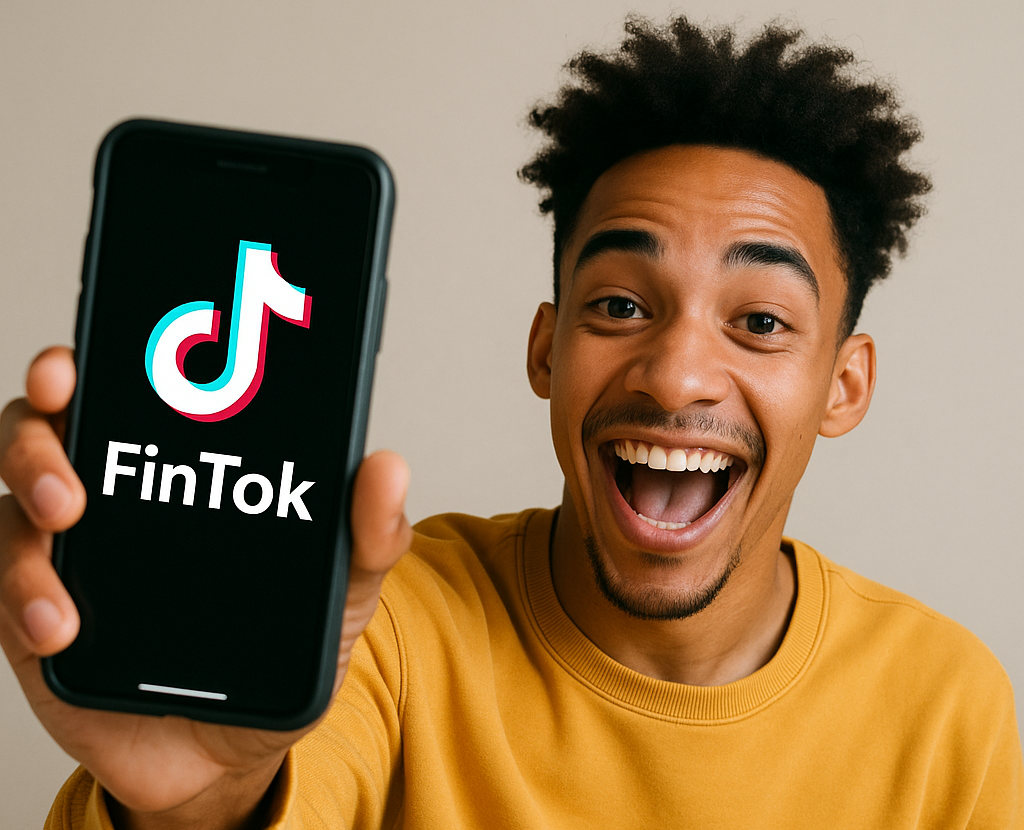The #FinTok Phenomenon

Why Is It So Popular Among Gen Z and Millennials?
Gen Z and Millennials are rewriting the rules of financial engagement—and they’re doing it on TikTok. With over 4.7 billion views, #FinTok isn’t just a trend—it’s changing the way younger consumers learn about, evaluate, and purchase financial products. For financial institutions, this shift represents both a challenge and a massive opportunity.
#FinTok is a global hashtag community on the social media platform TikTok. Consisting of users, influencers, and brands—including financial institutions—creators advise on budgeting, investing, side hustles, insurance, debt, and other financial matters.
FinTok helps build a sense of community around financial topics, with users sharing experiences, asking for advice, watching short videos, and joining in on discussions. FinTok users call this mix of finance and fun “Edutainment.” Here we’re taking a journey into #FinTok, looking at who is currently popular, and considering the place of financial institutions in the #FinTok universe—starting with the most popular Finfluencers.
Top 3 #FinTok Finfluencers

1. Erika Kullberg
Erika Kullberg describes herself as “an award-winning lawyer and personal finance expert featured in Inc. Magazine, CNBC, the Today Show, Business Insider and more.” She claims to be “the largest financial influencer in the world.” Her #FinTok stats are:
- 9M Followers
- 286 Following
- 75.1M Likes

2. Mark Tilbury
Mark Tilbury describes himself as a “self-made millionaire, who left school at 16 with no money and no qualifications.” As an entrepreneur, he claims to “have grossed over $50 million,” and his net worth is valued at $8 million. His #FinTok stats are:
- 7.9M Followers
- 94 Following
- 114.5M Likes
Mark’s #FinTok page is dedicated to providing advice on saving and budgeting, credit card management, and wealth building and investment from the point of view of somebody who doesn’t necessarily have a formal education or qualifications.

3. Humphrey Yang
Humphrey Yang describes himself as a “former financial advisor, creator and entrepreneur, who previously worked in tech.” He claims his strength is “explaining things and making it all fun and easy.” His #FinTok stats are:
- 3.4M Followers
- 501 Following
- 56.1M Likes
Humphrey’s #FinTok page is dedicated to educating viewers about personal finance, targeting mainly Gen Z. His claimed specialty is breaking down complex financial topics across investing, wealth building, and financial planning.
#FinTok: The Good, the Bad, and the Scams
TikTok draws a wide range of users, and the impact of #FinTok content largely depends on each viewer’s ability to evaluate what they’re seeing.
The Good
#FinTok reflects a growing interest in financial wellness, especially among Gen Z and Millennials who are eager to manage their money and connect with peers navigating similar challenges.
The Bad
Much of the advice shared on #FinTok, while well-meaning, is often based on personal experience rather than expertise—making it unreliable or even misleading.
The Scams
As #FinTok grows in popularity, so does the volume of scam content. Self-proclaimed “successful” influencers promote costly courses or products that may offer little actual value.
Financial Institutions on #FinTok
71% of Gen Z and 68% of Millennials say that social media has had a positive impact on their financial decisions. And with financial education absorbed by the financial wellness trend, many financial institutions have met this challenge by joining #FinTok.
Some of the Financial Institutions on FinTok include: Chime Online Banking, FNB Community Bank, Farmers State Bank, Step Bank, Navy Federal Credit Union, Royal Credit Union, Alliant Credit Union, and Genisys Credit Union.
Financial institutions appearing on #FinTok have specific goals. Strategic approaches include:
- Delivering #FinTok edutainment: Providing financial topics in the style of popular short-form videos to reach, help, and inspire younger consumers.
- Increasing brand awareness and trust: Posting valuable content and leveraging trust, financial institutions become more relevant in the eyes of consumers.
- Reaching targeted audiences: Influencer marketing allows for effective engagement with specific demographics.
- Future-proofing: Connecting with younger generations where they are, with the right message, is key to long-term growth.
Targeting #FinTok Users Effectively
#FinTok is a niche hashtag community made up of specific sub-groups—think Gen Z students, Millennial homebuyers, crypto enthusiasts, frugal living fans, and many more.
If you consider joining, start by defining your ideal consumer profile, then think about where your audience shows up. Where are they in their financial journey? How does your product or service support that?
For example, a credit union aiming to reach college students would need a different #FinTok approach—whether through influencer partnerships or original content—than a crypto mining app.
Financial institutions who do best on #FinTok tend to adapt to its culture, goals, and formats, often working with Finfluencers. At the same time, they are aware of compliance and regulatory factors at each step.
Trust + Convenience = Competitive Advantage
Financial institutions leveraging #FinTok should focus on the experience they deliver to users who engage with them after viewing content on the platform. This would include:
- Finding a realistic way to offer long-term products such as financial protection without overburdening staff or resources.
- Leveraging engagement strategies using data-based targeting to send the right messages to the right customers or members at the right time.
- Creating a frictionless experience by meeting customers or members at each touch point using your trusted brand exclusively.
#FinTok is not just a trend—it’s a proxy for how consumers want to engage with financial information as a whole: fast, convenient, and trusted.
Even if FinTok isn’t part of your marketing strategy, it’s worth paying attention to the principles behind its success: clear messaging, relatable content, and meeting consumers where they are.
And don’t forget the fun!


